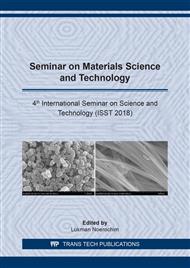[1]
R. Fajarin, H. Purwaningsih, Widyastuti, D. Susanti, and R. K. Helmy, Milling time and temperature dependence on Fe2TiO5 nanoparticles synthesized by mechanical alloying method,, 2014, p.63–66.
DOI: 10.1063/1.4897105
Google Scholar
[2]
M. Enhessari, M. K. Razi, L. Etemad, A. Parviz, and M. Sakhaei, Structural, optical and magnetic properties of the Fe2TiO5 nanopowders,, J. Exp. Nanosci., vol. 9, no. 2, p.167–176, Feb. (2014).
DOI: 10.1080/17458080.2011.649432
Google Scholar
[3]
M. Ramezani, A. Davoodi, A. Malekizad, and S. M. Hosseinpour-Mashkani, Synthesis and characterization of Fe2TiO5 nanoparticles through a sol–gel method and its photocatalyst applications,, J. Mater. Sci. Mater. Electron., vol. 26, no. 6, p.3957–3962, Jun. (2015).
DOI: 10.1007/s10854-015-2930-6
Google Scholar
[4]
A. V. Vinogradov, V. V. Vinogradov, T. V. Gerasimova, and A. V. Agafonov, Low-temperature sol–gel synthesis of nanosized pseudobrookite crystals without heat treatment,, J. Alloys Compd., vol. 535, p.102–107, Sep. (2012).
DOI: 10.1016/j.jallcom.2012.04.066
Google Scholar
[5]
M. Dondi, F. Matteucci, G. Cruciani, G. Gasparotto, and D. M. Tobaldi, Pseudobrookite ceramic pigments: Crystal structural, optical and technological properties,, Solid State Sci., vol. 9, no. 5, p.362–369, May (2007).
DOI: 10.1016/j.solidstatesciences.2007.03.001
Google Scholar
[6]
K. Hirota and R. C. Bradt, Sintering and Synthesis of The Pseudobrookite Oxide (Fe2TiO5) By Thes Solid State Reaction,, Anal. Sciences, vol. 7, p.1275–1278, (1991).
DOI: 10.2116/analsci.7.supple_1275
Google Scholar
[7]
J. Deng, X. Lv, J. Liu, H. Zhang, K. Nie, C. Hong, J. Wang, X. Sun, J. Zhong, S.-T. Lee,Thin-Layer Fe2TiO5 on Hematite for Efficient Solar Water Oxidation,, ACS Nano, vol. 9, p.5348–5356. (2015).
DOI: 10.1021/acsnano.5b01028
Google Scholar
[8]
C. Suryanarayana, Mechanical alloying and milling,, Prog. Mater. Sci., vol. 46, p.1–184, (2001).
Google Scholar
[9]
B. H. O'Connor and S. Pratapa, Improving the accuracy of Rietveld-derived lattice parameters by an order of magnitude,, Adv X-Ray Anal, vol. 45, p.158–165, (2002).
Google Scholar
[10]
D.L. Bish, and S.A. Howard,Quantitative phase analysis using the Rietveld method,, J. of App. Cryst. vol. 21, 86–91, (1988).
DOI: 10.1107/s0021889887009415
Google Scholar
[11]
A. N. Mallika, A. R. Reddy, and K. V. Reddy, Annealing effects on the structural and optical properties of ZnO nanoparticles with PVA and CA as chelating agents,, J. Adv. Ceram., vol. 4, no. 2, p.123–129, Jun. (2015).
DOI: 10.1007/s40145-015-0142-4
Google Scholar


